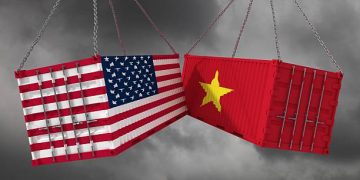The United States has announced a new trade agreement with Vietnam that will introduce a 20% tariff on Vietnamese imports, according to a statement shared by former President Donald Trump on social media this week.
The agreement, which has yet to be officially confirmed by both sides, is expected to grant the U.S. tariff-free access to Vietnam’s markets. As part of the deal, goods that are shipped from other countries but pass through Vietnam for final export to the U.S. — a practice known as transshipping — will be subject to a higher tariff rate of 40%.
The transshipment measure aims to address concerns that some exporters use Vietnam as a routing point to avoid existing trade restrictions. Vietnam’s role as a major exporter to the U.S. means these new rules could have significant implications for businesses relying on Vietnamese manufacturing and logistics channels.
The announcement comes just days before the scheduled end of a 90-day pause on broader U.S. tariffs on imports from multiple countries. That temporary suspension had reduced tariffs on Vietnamese goods to around 10%, down from an earlier blanket rate of 46%. The new 20% rate represents an increase from the interim level and may lead to higher costs for U.S. importers and potentially for consumers.
While the agreement’s exact implementation timeline remains unclear, reports indicate that further details are expected soon. White House aides have not confirmed the specific tariff rates, saying only that additional information will be provided.
Recent estimates suggest that even moderate tariff hikes can affect retail prices in the U.S. A retail pricing analysis by consulting firm AlixPartners indicated that a 10% tariff could raise the cost of an imported men’s sweater by about 8%. A return to the higher 46% rate would push that increase to roughly 35%.
Despite these concerns, the S&P 500 rose slightly following the announcement, as markets responded to news that the U.S. continues to negotiate trade terms with major partners. Vietnam, whose exports to the U.S. reportedly accounted for about 30% of its gross domestic product last year, is viewed as especially exposed to shifting U.S. trade policies.
Some analysts and industry groups continue to caution that higher tariffs could contribute to rising costs for American consumers, particularly on goods such as apparel and footwear. The U.S. Federal Reserve has indicated that the full economic effects of these trade measures are expected to become more noticeable in the coming months as earlier inventory buffers are depleted.
While critics argue that tariffs can increase consumer prices and create economic uncertainty, supporters maintain that tariff revenue strengthens U.S. trade leverage and government revenue. The administration has also signaled it is continuing to negotiate with other key trading partners, including the United Kingdom and other economies.
#SupplyChainNews #TradePolicy #Tariffs #VietnamTrade #NewsUpdate

















